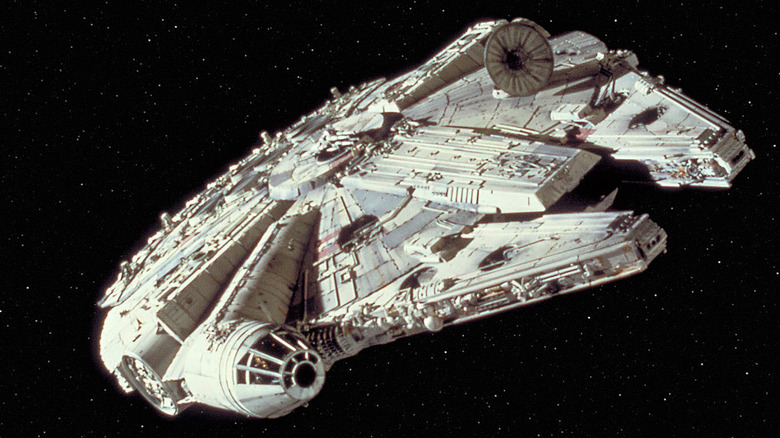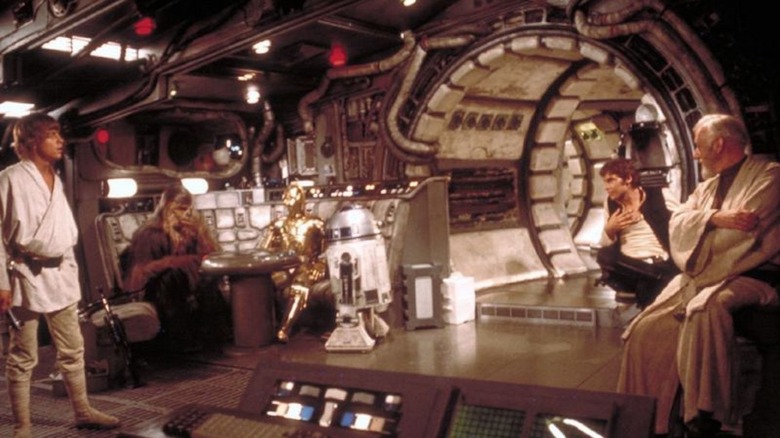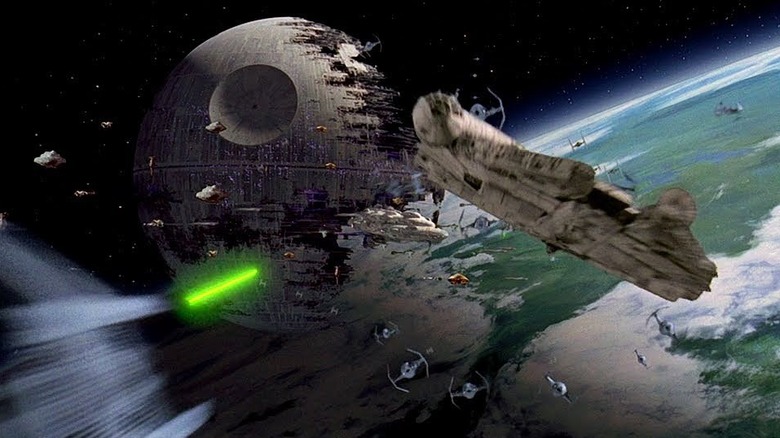How Some Dirty Dishes Inspired The Look Of Star Wars' Millennium Falcon
She's the ship that made the Kessel Run in less than 12 parsecs. She can outrun Imperial starships (not the local bulk cruisers mind you, but the big Corellian ships). She's fast. She is the Millennium Falcon, and while she may not look like much, she's got it where it counts. As for why she looks like, per Luke Skywalker, "a piece of junk," that's a surprisingly convoluted story born out of Joe Johnston's literal kitchen sink.
It's also a reminder of why George Lucas' "Star Wars" became a zeitgeist-capturing blockbuster the likes of which hadn't been seen since "Gone with the Wind." Lucas combined his love of Westerns, Akira Kurosawa's samurai films, and hot rods to make a sci-fi fantasy with a lived-in aesthetic. He wasn't trying to blow audiences away with sleek, futuristic design work (hence the film being set "a long time ago, in a galaxy far, far away"). He wanted his space opera to feel like a world ravaged by conflict. This meant his spacecraft had to look beaten to crap.
So when it came time to draw up Han Solo's hyperdrive-enhanced Millennium Falcon, Johnston, who would go on to concoct a whiz-bang classic with "The Rocketeer" and a moving tribute to the nobility of science with "October Sky," found his inspiration in mess.
A smuggler's ramshackle dream
In an interview for the "Light and Magic" docuseries currently streaming on Disney+, Johnston revealed that the gist of the iconic spacecraft resided in yesterday's dinner. According to Johnston:
"George had sent me off to design a new ship for Han Solo, and 'We need it fast.' I went home, I'm looking around the room as stuff, and there's this stack of dirty dishes. And I'm thinking, 'What if you took this dish and put another one on top of it?'"
This isn't that far from the "flying saucer" design that gained popularity in 1950s cinema, but the bizarre, gap-toothed bow and the cluttered interior gave the ship a rejiggered, souped-up quality that would've been right at home on the drag in Lucas' native Modesto, California. Appearance mattered, but the ability to dust some arrogant punk who thinks his ride has more giddy-up than yours was key.
And it fell to art director Roger Christian to make the Falcon look like the fleetest jalopy in the galaxy.
A beautiful bucket of bolts stripped of its rusty grandeur
As Christian told Inside during an interview pegged to the release of "Solo: A Star Wars Story," he ignored the space-age cliches embodied by "Flash Gordon," "Forbidden Planet," and "Barbarella," and looked to scrapyards. "I had the idea that if I bought scrap junk airplanes I could break it down and build the sets," said Christian. "That was key to making the Millennium Falcon."
So the next time you watch the original "Star Wars," keep in mind that you're looking at a set cobbled together with aircraft detritus and fighter-pilot seats. It's real. All of it. And that was crucial to selling Lucas' vision in 1977. It stinks that he's all but buried the original, non-"Special Edition" cut, because the CG enhancements have aged poorly in the 26 years since he shoehorned them into his brilliantly tactile classic. "Star Wars" got us dreaming because, once we learned its practical filmmaking tricks, we believed we could approximate the transporting experience in our parents' garage with a surfeit of ingenuity.
Back then, inspiration was just a pile of dirty dishes away. Now it's all ones and zeroes, a betrayal of the grease-stained, nuts-and-bolts pluck that briefly turned Lucas into one of the most exciting filmmakers on the planet.


